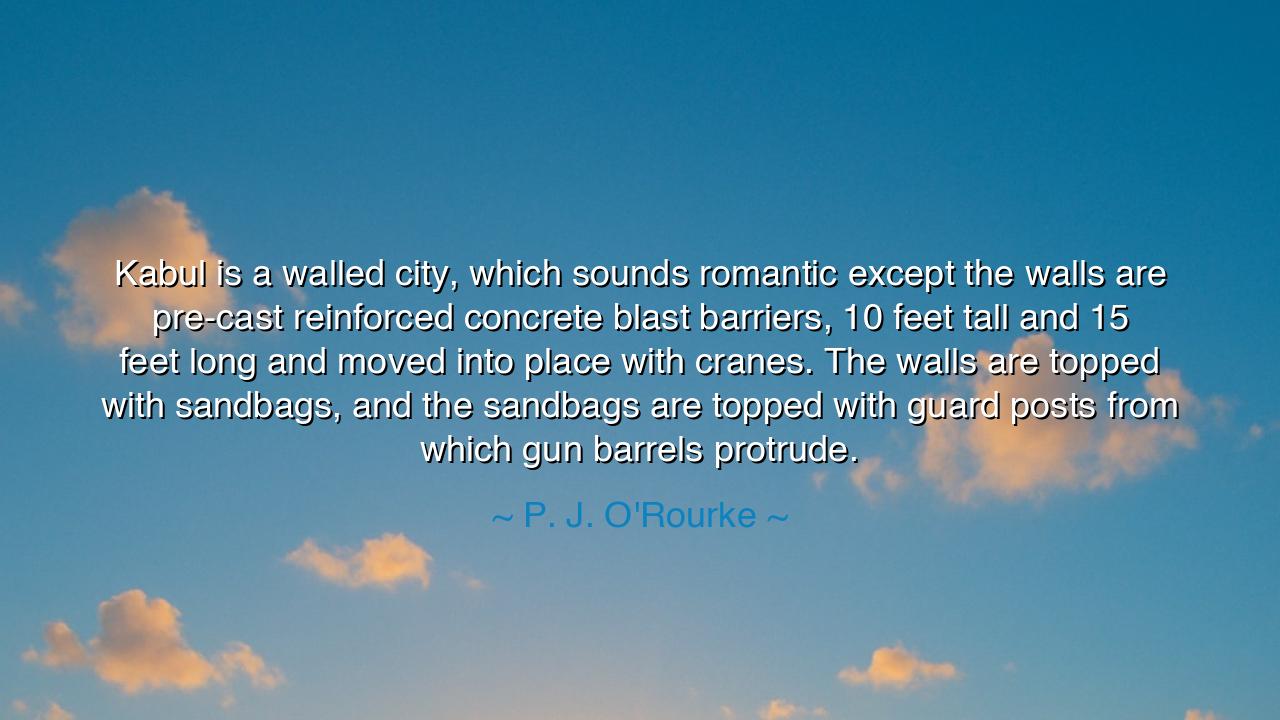
Kabul is a walled city, which sounds romantic except the walls
Kabul is a walled city, which sounds romantic except the walls are pre-cast reinforced concrete blast barriers, 10 feet tall and 15 feet long and moved into place with cranes. The walls are topped with sandbags, and the sandbags are topped with guard posts from which gun barrels protrude.






The words of P. J. O’Rourke—“Kabul is a walled city, which sounds romantic except the walls are pre-cast reinforced concrete blast barriers, 10 feet tall and 15 feet long and moved into place with cranes. The walls are topped with sandbags, and the sandbags are topped with guard posts from which gun barrels protrude”—are a reminder of the harsh difference between romantic imagination and brutal reality. He takes an image that once evoked poetry—the walled city, a place of mystery, safety, and ancient charm—and strips it of illusion, replacing it with the grim details of modern war: concrete, sandbags, and guns. In these words, we confront the way violence reshapes beauty, and how ideals are toppled by necessity.
The origin of this contrast lies in human history itself. For thousands of years, walls symbolized strength and civilization. The walls of Babylon were counted among the wonders of the world; the walls of Jerusalem carried divine meaning; the Great Wall of China was seen as both protection and majesty. To imagine a “walled city” is to summon images of ancient marketplaces, minarets rising in the sunset, and the romance of history. Yet O’Rourke pulls us into the modern age, where walls are no longer carved in stone by artisans, but dropped into place by cranes—cold, functional, stripped of spirit. Romance dies where fear builds the walls.
History gives us echoes of this transformation. Think of the Berlin Wall, once a line dividing two ideologies. To some, its presence spoke of order and strength, but to those who lived in its shadow, it was a prison, a scar across the city, a barrier not of romance but of despair. It did not inspire poetry but hunger for freedom. And when it fell, its fragments became relics not of beauty, but of warning: that walls built from fear are monuments to division. So too in Kabul, the walls are not symbols of heritage but of violence, not built to define a city’s greatness but to contain its suffering.
There is a sorrow in O’Rourke’s words, but also a sharp wisdom: that what appears “romantic” from a distance often crumbles when seen up close. The traveler’s dream of Kabul as an exotic, ancient city collides with the reality of war, where every wall conceals not gardens but weapons. To see clearly is not to despair, but to refuse illusion. The romance of imagination must always be weighed against the truth of reality, for only then can we act wisely.
The lesson for us is profound: we must be careful of the images we carry of the world. Do not fall in love with the shadows of things, but learn to see them as they are. To imagine the world romantically is natural; to cling to the illusion in the face of suffering is dangerous. In life, we too build walls—emotional, spiritual, societal. We may call them necessary, but often they arise from fear. Let us ask ourselves: are our own walls built for protection, or do they imprison us, cutting us off from compassion, love, and truth?
Practically, this means living with eyes open. When you encounter a person, a place, or a story, resist the temptation to see only the “romantic” version. Instead, look for what lies behind the walls. Ask what forces built them—love, fear, survival, greed? And when you build your own defenses, choose carefully: protect what is precious, yes, but do not let fear make you live forever behind barriers of your own creation.
Thus, O’Rourke’s words are not only about Kabul; they are about the human condition. Every age has built its walls, and every heart is tempted to imagine them as noble. But true wisdom is to see both the romance and the reality, to hold them together without flinching.
So let this truth be passed on: walls can either guard life or suffocate it. To call them romantic is folly; to see them as they are is wisdom. Tear down the walls built by fear, and build instead bridges of understanding, courage, and compassion. Only then will the world be more than a fortress of guns—it will be a home for the human soul.






AAdministratorAdministrator
Welcome, honored guests. Please leave a comment, we will respond soon